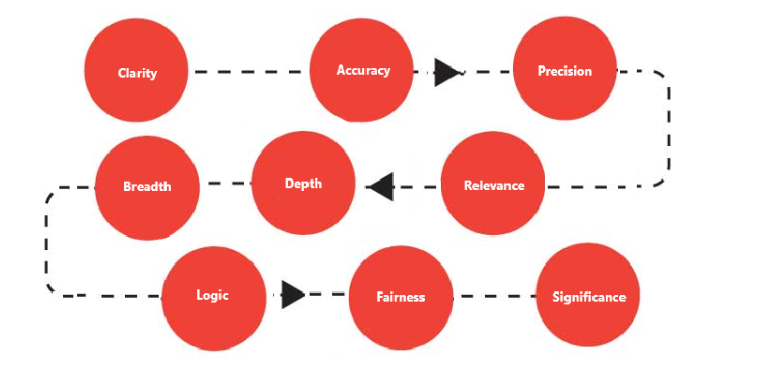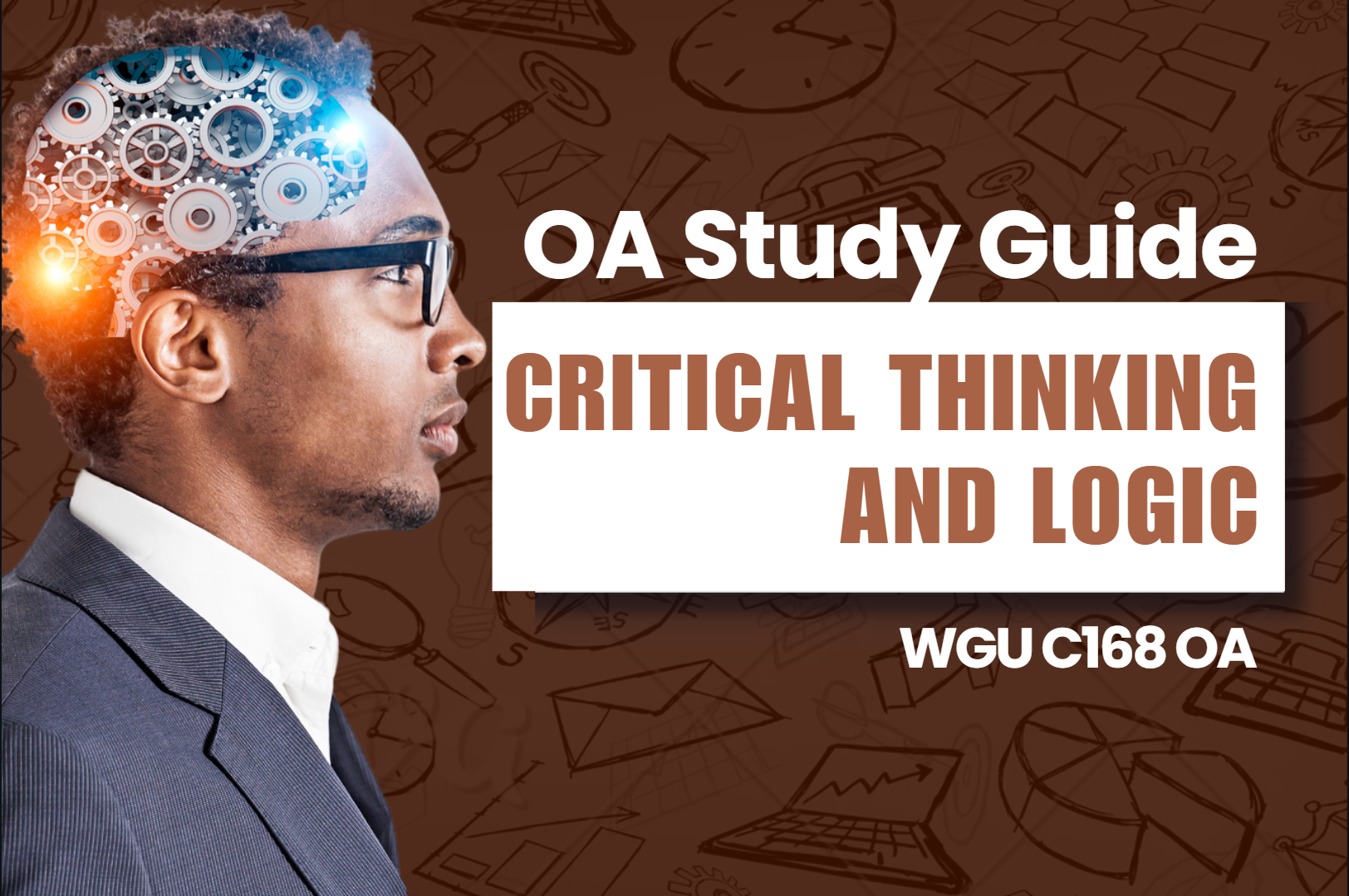WGU C168 OA Study Guide - 2025 | Fallacies, Mill’s Method, and the Nine Intellectual Standards 📖
Welcome to the wonderful world of critical thinking—where everything is up for debate and nothing is as simple as it seems (yes, even your favorite pizza topping might be questioned!). Whether you’re facing WGU C168 OA questions or just want to level up your thinking skills, this article will guide you through three essential topics:
This article explores three key concepts in critical thinking that are essential for evaluating arguments and reasoning effectively:
- Fallacies: Logical fallacies are errors in reasoning that weaken arguments. They can be deceptive and misleading, making it crucial to recognize common fallacies like ad hominem, straw man, and false cause to ensure sound decision-making.
- Mill’s Method: John Stuart Mill introduced five methods of inductive reasoning to help identify cause-and-effect relationships. These methods—such as the Method of Agreement and the Method of Difference—serve as valuable tools for drawing logical conclusions based on evidence.
- Nine Intellectual Standards: Critical thinking relies on intellectual standards like clarity, accuracy, precision, relevance, and logic. These nine standards help ensure that reasoning is well-structured, fair, and objective in problem-solving and decision-making.
Think of it as your personal toolkit for navigating the maze of arguments, spotting faulty reasoning, and sharpening your mind like never before. Ready to make your brain do some serious gym time? Let’s get started!
How to Use This Guide for the WGU C168 OA Exam?📖
The C168 Critical Thinking and Logic OA exam at WGU evaluates your understanding of logical reasoning, critical analysis, and the application of intellectual standards in problem-solving. This guide simplifies the key concepts of fallacies, Mills method, and the nine intellectual standards to help you grasp the topics tested in the exam.
We also provide exam-style questions and practical applications to ensure you’re fully prepared for the questions on the WGU C168 OA exam.

Fallacies: Understanding and Identifying Errors in Reasoning For C168 OA 📝
Recognition and prevention of fallacies stands as one of the essential competence development pathways in Critical Thinking and Logic (WGU C168). A fallacy exists as a rational mistake that produces incorrect logic that devalues or destroys an argument’s value. An incorrect argument prevents users from using sound reasoning thus causing misunderstandings which destroy meaningful dialogue.
This article introduces the concept of fallacies followed by their operational principles and vital importance together with steps for detection.
What is a Fallacy?
The fundamental concept of fallacy describes an error in sound reasoning. The construction of an argument contains an issue that produces this defect. A sound argument based on incorrect logic actually represents a fallacy even when it appears valid. The term stands apart from delivering incorrect information about actual events. The structure of an argument substantially determines whether it represents a fallacy or not. The validity of reasoning becomes essential for critical thinkers who want to confirm that their logic remains secure.
The principles of critical thinking help to define fallacies since they represent violations of these principles. To evaluate information properly persons need to follow logical and reasoned approaches while maintaining careful measurements. The presence of a fallacy creates an illusion that makes you think an argument is solid when it actually contains no value.
Fallacies vs. Cognitive Biases
To help clarify, let’s briefly compare fallacies with another related concept called cognitive biases. Both can lead to faulty reasoning, but they are different.
- A fallacy is a specific flaw in an argument, such as using irrelevant evidence or making unsupported claims. It’s about the structure of reasoning.
- A cognitive bias is a pattern of thinking that skews judgment, often based on personal experiences, memories, or emotions. For example, we might be more likely to accept information that confirms what we already believe, even if that information is flawed.
Understanding this distinction can help you spot not just flaws in arguments but also potential biases in your own thinking, something that can be very helpful when preparing for the WGU C168 OA.
Types of Fallacies
There are different categories of fallacies. These categories help us understand the various ways reasoning can go wrong. Here are some key categories:
- Fallacies of Inconsistency: These fallacies occur when an argument proposes something that is inconsistent or contradictory. For example, saying one thing and then contradicting it later on.
- Fallacies of Relevance: These fallacies involve irrelevant reasons that are presented as valid evidence. The argument might look logical at first, but upon closer inspection, it doesn’t actually support the conclusion.
- Fallacies of Insufficiency: This category happens when the evidence provided is too weak or insufficient to support the conclusion being made. It’s like trying to make a case with too little proof.
- Fallacies of Inappropriate Presumption: These fallacies occur when an assumption is made that’s unreasonable or unjustified in the context of the argument. It can also involve assuming something to be true without providing adequate evidence.
Common Fallacies and How to Spot Them
To make it easier for you to identify common fallacies, here’s a table that breaks down the key concepts and examples of each one:
Fallacy | Key Concept | Example |
Straw Man Fallacy | Misrepresenting an opponent’s argument to make it easier to attack. | John: “I think we should hire someone to redesign our website.” Lola: “Oh, so you want to throw our money away on external resources instead of building up our in-house design team?” |
Bandwagon Fallacy | Arguing that something is true because it is popular. | “Everyone at my school wears those shoes, so they must be the best shoes to buy.” |
False Dilemma | Presenting a situation as having only two mutually exclusive outcomes, ignoring other possibilities. | “You either support this new policy, or you don’t care about improving our work environment.” |
Hasty Generalization | Drawing a broad conclusion from insufficient evidence. | “I met two people from France, and they were both rude. So, all people from France must be rude.” |
Appeal to Authority | Relying too heavily on the opinion of an authority figure, especially outside their area of expertise. | “Our CEO said this new marketing strategy will work, so it must be the best approach.” |
False Cause | Assuming that because two events happened close together, one caused the other. | “The sales went up after we changed the logo, so the logo change must have caused the increase in sales.” |
How to Spot Fallacies
To avoid falling into the trap of fallacies, it’s essential to practice critical thinking. Here’s how you can spot fallacies in arguments:
1. Ask Questions:
- Does the reasoning make sense, or is it based on emotions or assumptions?
- Is the evidence strong enough to support the conclusion?
2. Analyze the Argument’s Structure:
- Look for any inconsistencies or contradictions in the argument.
- Check if the reasoning is logically sound or if it’s relying on irrelevant information.
3. Check for Alternative Explanations:
- A well-reasoned argument considers other possibilities, so be wary of arguments that limit the discussion unfairly or ignore key information.
Ready to dive deeper into how we make logical connections? Understanding Mill’s Methods will enhance your critical thinking skills, especially when tackling WGU C168 OA questions.
Mills Method: A Way to Find Causes Through Logical Thinking For C168 OA📝
When studying critical thinking and logic, one of the key skills is understanding cause-and-effect relationships. Mills Method, developed by philosopher John Stuart Mill, offers a structured way to identify what causes certain events. In this section, we’ll look at the five methods Mill developed to help you test and find causal relationships, which is especially useful when tackling WGU C168 OA questions.
What is Mills Method?
Mills Method consists of five techniques used to identify the cause of an event. These methods help you determine the cause of something by comparing situations and seeing what’s common or different in each. By applying these methods, you can make more logical conclusions when trying to understand cause and effect.
The Five Methods of Mill
Mill developed five distinct methods to test causal relationships. Think of them as tools in your critical thinking toolkit, each one helping you investigate different aspects of an event. Here’s a breakdown:
- Method of Agreement
The Method of Agreement focuses on finding a common factor among different instances where an event happens. If something happens in multiple situations, and the only thing that all situations share is one factor, that factor is likely the cause.
Example: If three people ate the same meal and all got food poisoning, the meal is likely the cause. - Method of Difference
To determine what differentiates between the event’s occurrence and non-occurrence you can use the Method of Difference approach. One factor plays a significant role in event occurrence because its presence in the initial situation and absence in the other situation links it to the event.
Example: If one group of people ate a certain food and got sick, but another group ate the same food and didn’t, the difference is likely the cause (perhaps the food was contaminated). - Method of Concomitant Variation
Two variables likely establish a cause-and-effect relationship when one variable matches the increase or decrease of the other variable.
Example: People consume additional water when temperature levels go up thus indicating that temperature and water consumption have a relationship. - Method of Residues
The Method of Residues involves eliminating factors you know are not the cause and focusing on what’s left. After ruling out possibilities, the remaining factor is likely the cause.
Example: If a plant is dying and you rule out lack of water, poor soil, and pests, the remaining possible cause is a lack of sunlight. - Method of Agreement and Difference Combined
This combines the first two methods to strengthen the analysis. By looking for common factors (Agreement) and isolating differences (Difference), you can make a more confident conclusion about the cause.
Example: If two groups ate the same food (Agreement) but only one got sick (Difference), this combination confirms that the food is likely the cause of the illness.
Why is Mills Method Important For C168 OA?
Using Mills Method is important for anyone studying critical thinking because it helps you test ideas and find logical conclusions about causes. WGU C168 OA questions along with real-life issues can be solved through Mills Method which helps people decide by using evidence in place of assumptions.
By using these techniques, you improve your ability to reason logically and avoid jumping to conclusions based on incomplete information. This is essential for making well-supported arguments in WGU C168 and beyond.
How to Use Mills Method in Practice
To use Mills Method effectively, follow these steps:
- Look for Patterns: Start by gathering as much information as you can. Use the Method of Agreement to see if there’s a common factor across different situations. Then, apply the Method of Difference to rule out other possibilities.
- Use Logic: Apply the Method of Residues by eliminating factors that are not relevant, leaving only the most likely cause.
- Observe Changes: Use the Method of Concomitant Variation to look for trends between two variables. If they change together in a consistent way, there may be a cause-and-effect relationship.
- Combine Methods: Don’t hesitate to combine multiple methods to improve the reliability of your findings. Using the Method of Agreement and Method of Difference together can give you a clearer picture of the cause.
Now that we’ve explored Mills Method to identify causes, let’s dive into the Nine Intellectual Standards to sharpen your reasoning and improve your WGU C168 OA answers.
Tired of reading blog articles?
Let’s Watch Our Free WGU C168 Practice Questions Video Below!

Nine Intellectual Standards: Key Principles for Better Thinking For C168 OA📖
Critical thinking and logic studies demand both excellent argumentation skills and substantial evaluation and enhancement of thinking quality. The Nine Intellectual Standards enable us to analyze how logical free from bias and efficient our thinking remains. The follow-up section will explain what these standards represent while describing their operational mechanics together with their essential role when addressing WGU C168 OA questions.
What Are the Nine Intellectual Standards?
The Nine Intellectual Standards are principles used to guide and improve our thinking. They help ensure that our reasoning is strong and clear. These standards allow us to evaluate both our own thinking and that of others. By applying these standards, you can organize your thoughts and make well-supported conclusions, which is especially useful when answering WGU C168 OA questions.
The Nine Intellectual Standards
Here’s a breakdown of the Nine Intellectual Standards:
- Clarity
Clarity ensures that your reasoning is easy to understand. If something is unclear, it’s hard for others to follow your argument. Always explain your ideas in a way that leaves no room for confusion.
Example: When discussing a new policy, explain it clearly so people understand its purpose and effects. - Accuracy
A precise focus refers to verifying that every piece of information remains accurate. The strength of an argument depends entirely on the validated facts which support it. The quality of your conclusion will suffer when you provide incorrect information about the problem.
Example: If you’re discussing climate change, use accurate data and facts, not assumptions or misinformation. - Precision
Precision means being specific and detailed in your reasoning. General statements are often too vague. To strengthen your argument, be as specific as possible.
Example: Instead of saying, “Many people are affected by pollution,” say, “Over 90% of people in urban areas experience harmful levels of air pollution.” - Relevance
Relevance ensures your points directly relate to the topic. If you introduce unrelated information, it weakens the argument and distracts from the issue at hand.
Example: When discussing healthcare, avoid talking about unrelated topics like weather conditions. Stick to the subject. - Depth
Depth means addressing the complexities of a situation. Superficial reasoning might overlook important details. Think critically about the underlying issues and explore them thoroughly.
Example: When discussing poverty, consider social, economic, and political factors, rather than just focusing on individual struggles. - Breadth
Breadth encourages you to consider different perspectives. A narrow view can miss key details. Look at multiple sides of the issue to form a more complete conclusion.
Example: When debating education reform, include the views of teachers, students, and policymakers to ensure a broader perspective. - Logic
Logic means ensuring your reasoning makes sense. If your argument is logically flawed, your conclusion cannot be trusted. Ensure that your reasoning is consistent and follows a rational path.
Example: A statement like “All students who do well in school are good at math, so all students who are good at math do well in school” is logically flawed. It assumes math is the only reason for academic success, which is not true. - Fairness
Fairness is about being open-minded and objective. Consider all viewpoints and evidence without bias. A fair thinker listens to others and weighs all sides of the argument.
Example: If discussing a new law, consider how it might impact different groups of people, including those who disagree with you. - Significance
The essence of significance remains in identifying the essential matters. Pay the closest attention to fundamental elements of the issue by staying away from less important details.
Example: When debating healthcare reform, focus on critical issues like access to care and affordability, rather than minor administrative details.
Why Are the Nine Intellectual Standards Important For C168 OA?
Your intellectual development becomes possible through the proper application of the Nine Intellectual Standards. These standards provide assessment tools that improve your reasoning ability and produce extensive support for your conclusions. Using the nine intellectual standards will help you solve WGU C168 OA questions properly.
The combination of clarity accuracy and fairness as your focus will help you avoid common errors in your reasoning process. You will confront complex matters through comprehensive analysis by using these standards to analyze multiple viewpoints for making informed decisions.
How to Apply the Nine Intellectual Standards
To use the Nine Intellectual Standards effectively, here’s what you can do:
- Evaluate Your Arguments: Before finalizing an argument, check whether it meets all nine standards. Are your points clear, accurate, and logical?
- Consider Different Views: Use breadth and fairness to explore various perspectives and understand all aspects of the issue.
- Address Complexity: Apply depth to tackle the complexities of the problem, looking beyond surface-level explanations.
- Focus on What Matters: Use significance to filter out irrelevant details, ensuring that your argument addresses the most important factors.

Wrapping Up: Ace Your WGU C168 OA with Fallacies, Mills Method, and Intellectual Standards 📖
As we wrap up this critical thinking journey, remember that mastering Fallacies, Mills Method, and the Nine Intellectual Standards will give you the edge you need in your WGU C168 OA. The concepts should not be treated as memorization tools since they serve as essential elements to enhance logical thinking and create strong arguments and intelligent decision-making. Your understanding of these concepts will prepare you to succeed at challenging questions in the Open-Response section. Good luck—your critical thinking skills are about to get a serious upgrade!






